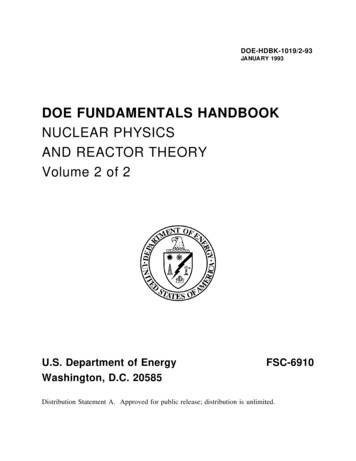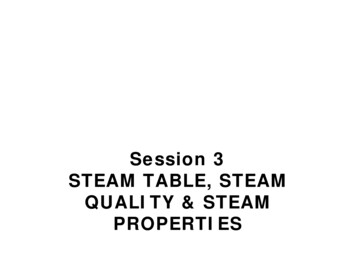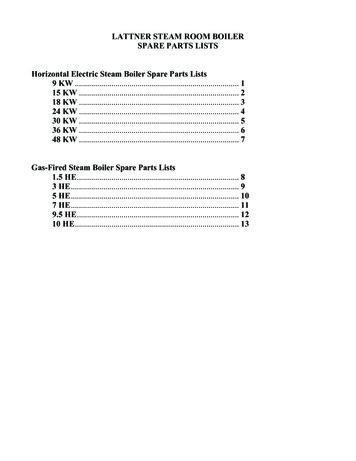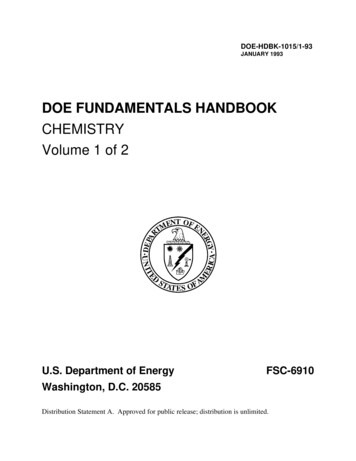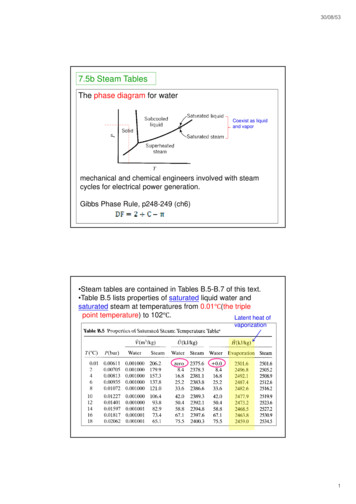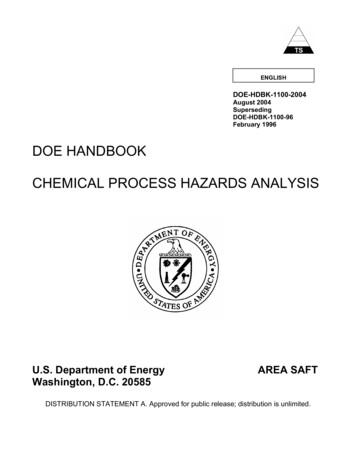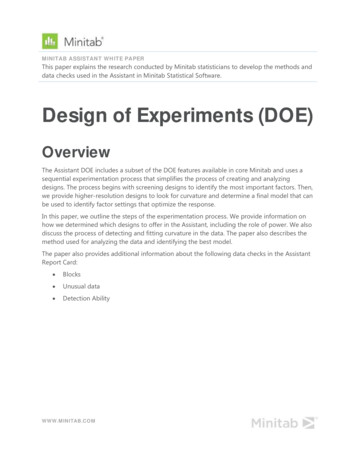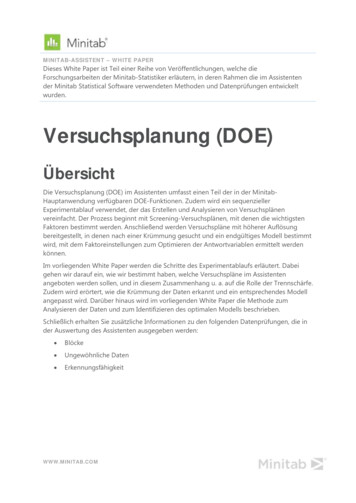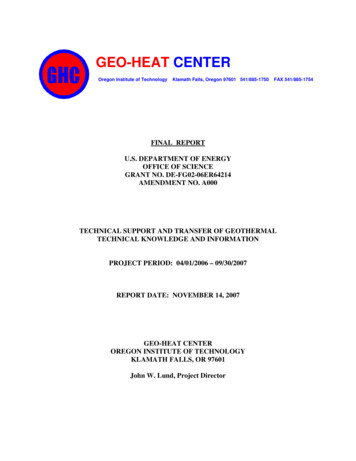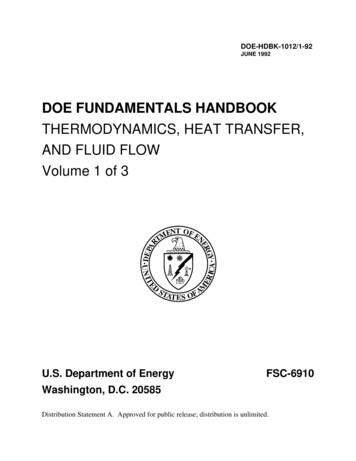
Transcription
DOE-HDBK-1012/1-92JUNE 1992DOE FUNDAMENTALS HANDBOOKTHERMODYNAMICS, HEAT TRANSFER,AND FLUID FLOWVolume 1 of 3U.S. Department of EnergyFSC-6910Washington, D.C. 20585Distribution Statement A. Approved for public release; distribution is unlimited.
This document has been reproduced directly from the best available copy.Available to DOE and DOE contractors from the Office of Scientific and Technical Information.P. O. Box 62, Oak Ridge, TN 37831; (615) 576-8401.Available to the public from the National Technical Information Service, U.S. Department ofCommerce, 5285 Port Royal Rd., Springfield, VA 22161.Order No. DE92019789
THERMODYNAMICS, HEAT TRANSFER, AND FLUID FLOWABSTRACTThe Thermodynamics, Heat Transfer, and Fluid Flow Fundamentals Handbook wasdeveloped to assist nuclear facility operating contractors provide operators, maintenancepersonnel, and the technical staff with the necessary fundamentals training to ensure a basicunderstanding of the thermal sciences. The handbook includes information on thermodynamicsand the properties of fluids; the three modes of heat transfer - conduction, convection, andradiation; and fluid flow, and the energy relationships in fluid systems. This information willprovide personnel with a foundation for understanding the basic operation of various types of DOEnuclear facility fluid systems.Key Words: Training Material, Thermodynamics, Heat Transfer, Fluid Flow, Bernoulli'sEquationRev. 0HT
THERMODYNAMICS, HEAT TRANSFER, AND FLUID FLOWFOREWORDThe Department of Energy (DOE) Fundamentals Handbooks consist of ten academicsubjects, which include Mathematics; Classical Physics; Thermodynamics, Heat Transfer, and FluidFlow; Instrumentation and Control; Electrical Science; Material Science; Mechanical Science;Chemistry; Engineering Symbology, Prints, and Drawings; and Nuclear Physics and ReactorTheory. The handbooks are provided as an aid to DOE nuclear facility contractors.These handbooks were first published as Reactor Operator Fundamentals Manuals in 1985for use by DOE Category A reactors. The subject areas, subject matter content, and level of detailof the Reactor Operator Fundamentals Manuals was determined from several sources. DOECategory A reactor training managers determined which materials should be included, and servedas a primary reference in the initial development phase. Training guidelines from the commercialnuclear power industry, results of job and task analyses, and independent input from contractorsand operations-oriented personnel were all considered and included to some degree in developingthe text material and learning objectives.The DOE Fundamentals Handbooks represent the needs of various DOE nuclear facilities'fundamentals training requirements. To increase their applicability to nonreactor nuclear facilities,the Reactor Operator Fundamentals Manual learning objectives were distributed to the NuclearFacility Training Coordination Program Steering Committee for review and comment. To updatetheir reactor-specific content, DOE Category A reactor training managers also reviewed andcommented on the content. On the basis of feedback from these sources, information that appliedto two or more DOE nuclear facilities was considered generic and was included. The final draftof each of these handbooks was then reviewed by these two groups. This approach has resultedin revised modular handbooks that contain sufficient detail such that each facility may adjust thecontent to fit their specific needs.Each handbook contains an abstract, a foreword, an overview, learning objectives, and textmaterial, and is divided into modules so that content and order may be modified by individual DOEcontractors to suit their specific training needs. Each subject area is supported by a separateexamination bank with an answer key.The DOE Fundamentals Handbooks have been prepared for the Assistant Secretary forNuclear Energy, Office of Nuclear Safety Policy and Standards, by the DOE Training CoordinationProgram. This program is managed by EG&G Idaho, Inc.Rev. 0HT
THERMODYNAMICS, HEAT TRANSFER, AND FLUID FLOWOVERVIEWThe Department of Energy Fundamentals Handbook entitled Thermodynamics, HeatTransfer, and Fluid Flow was prepared as an information resource for personnel who areresponsible for the operation of the Department's nuclear facilities. A basic understanding of thethermal sciences is necessary for DOE nuclear facility operators, maintenance personnel, and thetechnical staff to safely operate and maintain the facility and facility support systems. Theinformation in the handbook is presented to provide a foundation for applying engineeringconcepts to the job. This knowledge will help personnel more fully understand the impact thattheir actions may have on the safe and reliable operation of facility components and systems.The Thermodynamics, Heat Transfer, and Fluid Flow handbook consists of three modulesthat are contained in three volumes. The following is a brief description of the informationpresented in each module of the handbook.Volume 1 of 3Module 1 - ThermodynamicsThis module explains the properties of fluids and how those properties areaffected by various processes. The module also explains how energy balances canbe performed on facility systems or components and how efficiency can becalculated.Volume 2 of 3Module 2 - Heat TransferThis module describes conduction, convection, and radiation heat transfer. Themodule also explains how specific parameters can affect the rate of heat transfer.Volume 3 of 3Module 3 - Fluid FlowThis module describes the relationship between the different types of energy in afluid stream through the use of Bernoulli's equation. The module also discussesthe causes of head loss in fluid systems and what factors affect head loss.Rev. 0HT
THERMODYNAMICS, HEAT TRANSFER, AND FLUID FLOWThe information contained in this handbook is by no means all encompassing. Anattempt to present the entire subject of thermodynamics, heat transfer, and fluid flow would beimpractical. However, the Thermodynamics, Heat Transfer, and Fluid Flow handbook doespresent enough information to provide the reader with a fundamental knowledge level sufficientto understand the advanced theoretical concepts presented in other subject areas, and to betterunderstand basic system and equipment operations.Rev. 0HT
Department of EnergyFundamentals HandbookTHERMODYNAMICS, HEAT TRANSFER,AND FLUID FLOWModule 1Thermodynamics
ThermodynamicsTABLE OF CONTENTSTABLE OF CONTENTSLIST OF FIGURES . . . . . . . . . . . . . . . . . . . . . . . . . . . . . . . . . . . . . . . . . . . . . . . . .ivLIST OF TABLES . . . . . . . . . . . . . . . . . . . . . . . . . . . . . . . . . . . . . . . . . . . . . . . . . . viiREFERENCES . . . . . . . . . . . . . . . . . . . . . . . . . . . . . . . . . . . . . . . . . . . . . . . . . . . . viiiOBJECTIVES . . . . . . . . . . . . . . . . . . . . . . . . . . . . . . . . . . . . . . . . . . . . . . . . . . . . . . xTHERMODYNAMIC PROPERTIES . . . . . . . . . . . . . . . . . . . . . . . . . . . . . . . . . . . . . . 1Mass and Weight . . . . . . . . . . . .Specific Volume . . . . . . . . . . . .Density . . . . . . . . . . . . . . . . . .Specific Gravity . . . . . . . . . . . .Humidity . . . . . . . . . . . . . . . . .Intensive and Extensive PropertiesSummary . . . . . . . . . . . . . . . . .1334445TEMPERATURE AND PRESSURE MEASUREMENTS . . . . . . . . . . . . . . . . . . . . . . . . 6Temperature . . . . .Temperature ScalesPressure . . . . . . . .Pressure Scales . . .Summary . . . . . . .669912ENERGY, WORK, AND HEAT . . . . . . . . . . . . . . . . . . . . . . . . . . . . . . . . . . . . . . . . 14Energy . . . . . . . . . . . . . . . . . .Potential Energy . . . . . . . . . . .Kinetic Energy . . . . . . . . . . . .Specific Internal Energy . . . . . .Specific P-V Energy . . . . . . . .Specific Enthalpy . . . . . . . . . .Work . . . . . . . . . . . . . . . . . . .Heat . . . . . . . . . . . . . . . . . . . .Entropy . . . . . . . . . . . . . . . . .Energy and Power EquivalencesSummary . . . . . . . . . . . . . . . .Rev. 0.Page i.1414151617181819222325HT-01
TABLE OF CONTENTSThermodynamicsTABLE OF CONTENTS (Cont.)THERMODYNAMIC SYSTEMS AND PROCESSES . . . . . . . . . . . . . . . . . . . . . . . . . 26Thermodynamic Systems and SurroundingsTypes of Thermodynamic Systems . . . . . .Thermodynamic Equilibrium . . . . . . . . . . .Control Volume . . . . . . . . . . . . . . . . . . .Steady State . . . . . . . . . . . . . . . . . . . . . .Thermodynamic Process . . . . . . . . . . . . . .Cyclic Process . . . . . . . . . . . . . . . . . . . . .Reversible Process . . . . . . . . . . . . . . . . . .Irreversible Process . . . . . . . . . . . . . . . . .Adiabatic Process . . . . . . . . . . . . . . . . . .Isentropic Process . . . . . . . . . . . . . . . . . .Polytropic Process . . . . . . . . . . . . . . . . . .Throttling Process . . . . . . . . . . . . . . . . . .Summary . . . . . . . . . . . . . . . . . . . . . . . .2627272727282828282929292930CHANGE OF PHASE . . . . . . . . . . . . . . . . . . . . . . . . . . . . . . . . . . . . . . . . . . . . . . . 31Classification of Properties . . . . .Saturation . . . . . . . . . . . . . . . . .Saturated and Subcooled Liquids .Quality . . . . . . . . . . . . . . . . . . .Moisture Content . . . . . . . . . . . .Saturated and Superheated VaporsConstant Pressure Heat Addition .Critical Point . . . . . . . . . . . . . .Fusion . . . . . . . . . . . . . . . . . . .Sublimation . . . . . . . . . . . . . . .Triple Point . . . . . . . . . . . . . . .Condensation . . . . . . . . . . . . . .Summary . . . . . . . . . . . . . . . . .31333334353535363637373839PROPERTY DIAGRAMS AND STEAM TABLES . . . . . . . . . . . . . . . . . . . . . . . . . . . 41Property Diagrams . . . . . . . . . . . . . . . .Pressure-Temperature (P-T) Diagram . . .Pressure-Specific Volume (P-v) DiagramPressure-Enthalpy (P-h) Diagram . . . . . .Enthalpy-Temperature (h-T) Diagram . . .HT-01.Page ii.4142434445Rev. 0
ThermodynamicsTABLE OF CONTENTSTABLE OF CONTENTS (Cont.)Temperature-Entropy (T-s) Diagram . . . .Enthalpy-Entropy (h-s) or Mollier DiagramSteam Tables . . . . . . . . . . . . . . . . . . . .Summary . . . . . . . . . . . . . . . . . . . . . . .46474752FIRST LAW OF THERMODYNAMICS . . . . . . . . . . . . . . . . . . . . . . . . . . . . . . . . . . 53First Law of Thermodynamics . . . . . . . . . . . . . . . . . . . . . . . . . . . . . . . . . . . . . 53Summary . . . . . . . . . . . . . . . . . . . . . . . . . . . . . . . . . . . . . . . . . . . . . . . . . . . 68SECOND LAW OF THERMODYNAMICS . . . . . . . . . . . . . . . . . . . . . . . . . . . . . . . . 69Second Law of Thermodynamics . . . .Entropy . . . . . . . . . . . . . . . . . . . . .Carnot’s Principle . . . . . . . . . . . . . .Carnot Cycle . . . . . . . . . . . . . . . . . .Diagrams of Ideal and Real ProcessesPower Plant Components . . . . . . . . .Heat Rejection . . . . . . . . . . . . . . . .Typical Steam Cycle . . . . . . . . . . . .Causes of Inefficiency . . . . . . . . . . .Summary . . . . . . . . . . . . . . . . . . . .69707171777885909596COMPRESSION PROCESSES . . . . . . . . . . . . . . . . . . . . . . . . . . . . . . . . . . . . . . . . . 97Boyle’s and Charles’ Laws . . . . . . . . . . . . . . . . . .Ideal Gas Law . . . . . . . . . . . . . . . . . . . . . . . . . . .Fluid . . . . . . . . . . . . . . . . . . . . . . . . . . . . . . . . .Compressibility of Fluids . . . . . . . . . . . . . . . . . . .Constant Pressure Process . . . . . . . . . . . . . . . . . . .Constant Volume Process . . . . . . . . . . . . . . . . . . .Effects of Pressure Changes on Fluid Properties . . .Effects of Temperature Changes on Fluid PropertiesSummary . .
This Portable Document Format (PDF) file contains bookmarks, thumbnail s, and hyperlinks to help you navigate through the document. The modules listed in the Overview are linked to the corresponding pages. Text head ings in each module are linked to and from the table of contents for tha t module. Click on the DOE seal below to move to the .
